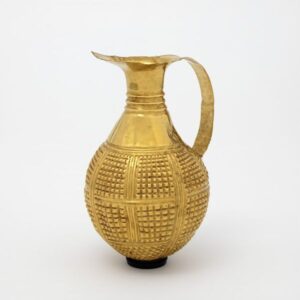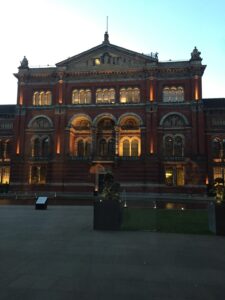Founder Shares Expertise for the Repatriation of a Turkish Ewer from the Gilbert Collection (Provenance Series Part XIX)
 Today, the Gilbert Trust for the Arts in London announced the return a 4,250-year-old Anatolian gold ewer from the Gilbert Collection to Turkey. The Gilbert Collection was created by Arthur Gilbert (1913-2001), who amassed an outstanding collection of British and European decorative arts that is currently on long-term loan to the Victoria & Albert Museum (the V&A). Unbeknownst to Gilbert, the ewer was the product of illegal excavation and export. This came to light in 2019, after the Gilbert Trust for the Arts, which is responsible for managing the collection, performed an extensive provenance research project revealing the ewer’s connection to an unscrupulous antiquities dealer who concealed its true origins. Our founder, Leila A. Amineddoleh, played a role during this process as she shared her expertise in repatriation matters with the Gilbert Trust’s researchers and provided advice on what approach to adopt (based on legal and ethical grounds).
Today, the Gilbert Trust for the Arts in London announced the return a 4,250-year-old Anatolian gold ewer from the Gilbert Collection to Turkey. The Gilbert Collection was created by Arthur Gilbert (1913-2001), who amassed an outstanding collection of British and European decorative arts that is currently on long-term loan to the Victoria & Albert Museum (the V&A). Unbeknownst to Gilbert, the ewer was the product of illegal excavation and export. This came to light in 2019, after the Gilbert Trust for the Arts, which is responsible for managing the collection, performed an extensive provenance research project revealing the ewer’s connection to an unscrupulous antiquities dealer who concealed its true origins. Our founder, Leila A. Amineddoleh, played a role during this process as she shared her expertise in repatriation matters with the Gilbert Trust’s researchers and provided advice on what approach to adopt (based on legal and ethical grounds).
As a result of its discussions with the Turkish Ministry of Culture, the Gilbert Trust officially donated the ewer to the Museum of Anatolian Civilizations in Ankara and commissioned a leading contemporary metalsmith to create a piece addressing the object’s history, to be displayed at the V&A in December. This recreation will allow the ewer to remain present in the museum’s galleries and initiate a constructive dialogue on the importance of proactive provenance research, collaboration, and exchange. While other institutions are sometimes wary of repatriating objects without a legal requirement to do so, the Gilbert Trust’s actions demonstrate that it is possible to return cultural objects in a way that is both respectful to current possessors and takes the source country’s wishes into consideration, leading to a mutually beneficial solution.
The Ewer’s Provenance
 Not only is the ewer a stunning example of ancient metalwork, it also possesses a fascinating history. This masterpiece was created by a Hattian goldsmith living in Anatolia over 4,000 years ago. The ewer was formed by embossing a single sheet of gold with complex patterns, including an ancient symbol of the sun, in order to accompany a Hattian ruler into the afterlife. When Gilbert acquired the ewer in 1989, he was dazzled by the evocative story as well as its beauty. However, because Gilbert was not very experienced in collecting these types of objects (this was the only archaeological object he ever bought), the seller was able to conceal the ewer’s illicit origins and misrepresent the origins of the piece.
Not only is the ewer a stunning example of ancient metalwork, it also possesses a fascinating history. This masterpiece was created by a Hattian goldsmith living in Anatolia over 4,000 years ago. The ewer was formed by embossing a single sheet of gold with complex patterns, including an ancient symbol of the sun, in order to accompany a Hattian ruler into the afterlife. When Gilbert acquired the ewer in 1989, he was dazzled by the evocative story as well as its beauty. However, because Gilbert was not very experienced in collecting these types of objects (this was the only archaeological object he ever bought), the seller was able to conceal the ewer’s illicit origins and misrepresent the origins of the piece.
In fact, Bruce McNall – the antiquities dealer who sold the work to Gilbert – later admitted to smuggling ancient artifacts out of source countries like Italy, Greece and Turkey. He worked alongside his partner, Robert E. Hecht, to sell items to unsuspecting buyers. McNall is a colorful figure who once owned Thoroughbred racehorses as well as sports teams (the Los Angeles Kings of the National Hockey League and the Toronto Argonauts of the Canadian Football League), enjoying a great deal of commercial success. However, his fall from grace in the early 1990s after defaulting on a $90 million loan resulted in bankruptcy and a 6-year stint in prison. McNall’s autobiography, published in 2003, details his partnership with Hecht and offers a glimpse into the world of illicit antiquities trafficking. According to the book, at one point Hecht occupied the dubious honor of being the world’s largest source of recently discovered antiquities, which he was able to procure thanks to monetary resources and an extensive network of grave robbers, smugglers, and intermediaries. Once items were obtained, they passed through countries without export controls and then onto Hecht, who sold them on to a collector or dealer. In order to sell the illusion that an item’s provenance was above board, Hecht would spin tales about its location in private homes and the like for the past several decades. As his reputation – and notoriety – increased, buyers would come to Hecht knowing that he could procure rare and valuable pieces. This included McNall, who later opened a gallery on Rodeo Drive in Los Angeles supplied mainly by Hecht’s dubious dealings. Both men drove the market for ancient art amongst the wealthy, creating false sales receipts and invoices from foreign-based companies (usually set up by McNall and Hecht) to cover their tracks.
Notably, Hecht was also tied to the Euphronios Krater later returned to Italy by the Metropolitan Museum of Art. In 2005, Hecht was charged with trafficking in looted antiquities alongside former Getty Museum curator Marion True and Italian dealer Giacomo Medici, but the case was dismissed in Italian court because the statute of limitations expired before the verdict was issued. He moved to Paris in the wake of the scandal, where he eventually passed away in 2012 – although his legacy lives on in the remaining looted objects that passed through his hands and are dispersed throughout the world.
The Importance of Provenance Research
During the period when McNall and Hecht were active, provenance research was not given the same importance it holds today. For the majority of purchasers, including museums, not asking in-depth questions about provenance or looking the other way when confronted with suspicious ownership histories was considered the norm. However, nowadays museums and private collectors increasingly acknowledge the crucial role of provenance research in upholding the legitimacy and ethical role of cultural institutions as stewards for the public.
 It is commendable when a collection proactively engages in discussions with foreign entities to right a past wrong. By following this course of action, it is possible for all stakeholders to determine the best outcome for displaced antiquities, without resorting to contentious and costly litigation (an expense that is burdensome for both private institutions and government entities). As such, creative results are possible, as in the Gilbert Trust’s agreement with Turkey. The Gilbert Trust made the decision to engage in proactive discussions with Turkey, a nation known to aggressively protect its cultural heritage and demand the repatriation of looted objects. However, by digging deeper into its collection to understand their histories, the ewer will finally return to its home, the Gilbert Collection will retain its unblemished reputation, and the V&A is engaging the public in discussions concerning ownership, history, and museum ethics.
It is commendable when a collection proactively engages in discussions with foreign entities to right a past wrong. By following this course of action, it is possible for all stakeholders to determine the best outcome for displaced antiquities, without resorting to contentious and costly litigation (an expense that is burdensome for both private institutions and government entities). As such, creative results are possible, as in the Gilbert Trust’s agreement with Turkey. The Gilbert Trust made the decision to engage in proactive discussions with Turkey, a nation known to aggressively protect its cultural heritage and demand the repatriation of looted objects. However, by digging deeper into its collection to understand their histories, the ewer will finally return to its home, the Gilbert Collection will retain its unblemished reputation, and the V&A is engaging the public in discussions concerning ownership, history, and museum ethics.
